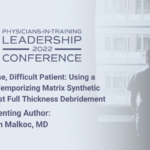Abstract | April 5, 2022
Difficult Disease, Difficult Patient: Using a Biodegradable Temporizing Matrix Synthetic Dermal Repair Post Full Thickness Debridement
Learning Objectives
- This case series describes two difficult patients and the relative ease of use and management of a synthic dermis to treat a complex skin wound.
- Complex skin wound treatments can be simplified even for the most difficult patients.
Introduction: Acellular dermal substitutes, along with skin grafting, have allowed treatment of full skin thickness loss due to surgical debridement for difficult wound beds like necrotizing fasciitis and suppurativa hidradenitis. Patient non-compliance, complex wound care, infection, product fragility and financial implications have thus far prevented their widespread adaptation. Biodegradable Temporizing Matrix (BTM™) has been demonstrated to function as a dermal scaffold that has robust handling characteristics and requires minimal wound care. This study reports two non-compliant patients with large complex full thickness wounds that were successfully managed despite poor wound care and long delays in definitive coverage with one patient epithelizing without skin grafting.
Case Presentation Case-1: A 40-year-old female with necrotizing fasciitis from heroine injection involving her right buttock and thigh was in septic shock and recovering after debriding 1400 sq cm. The debrided area was then covered with BTM™, stapled in place. This patient ultimately left against medical advice and returned to the ER two months later endorsing homelessness and noncompliance with wound management. Case-2: A 50-year-old African-American male with a 20 pack-year tobacco smoking history, methamphetamine use, phencyclidine use, and marijuana use presented with sepsis secondary to severe perianal Hidradenitis Suppurativa (HS) with cellulitis. The patient underwent full thickness excision with placement of 400 cm2 of dermal substitute with wound vacuum therapy and a diverting loop ileostomy. The patient left against medical advice on day two after surgery. He was given directions for local wound care with polysporin and xeroform gauze.
Management: The 40-year-old female, the BTM™ had fully incorporated by the time she returned with the silastic layer still stapled on although separated. Split thickness skin graft was performed without incident. The patient with HS ultimately followed up six months after discharge. The dermal substitute that was placed showed no fluctuance, purulence, or contractures. The silastic layer had fallen off with the wound fully epithelialized via marginal migration.
Conclusion: The robust characteristic, resistance to infection, and ease of wound care of BTM™ provided a solution to difficult patients with difficult problems. In one case, staged split thickness skin graft was not needed with complete epithiealization without contracture.
References and Resources:
- Alharbi Z, Kauczok J, Pallua N. A review of wide surgical excision of hidradenitis suppurativa. BMC Dermatol. 2012;12(1):9.
- Portella JP, da Silva IA, Castellani L, Matthes GZ. Hidradenitis suppurativa: surgical treatment with latissimus dorsi muscle flap. Mastology Impr. 2019;198–202.
- Rompel R, Petres J. Long‐term results of wide surgical excision in 106 patients with hidradenitis suppurativa. Dermatol Surg. 2000;26(7):638–643.
- Wagstaff MJ, Schmitt BJ, Caplash Y, Greenwood JE. Free flap donor site reconstruction: a prospective case series using an optimized polyurethane biodegradable temporizing matrix. Eplasty. 2015;15.
- Greenwood J. The evolution of acute burn care–retiring the split skin graft. Ann R Coll Surg Engl. 2017;99(06):432–438.
- Larson KW, Austin CL, Thompson SJ. Treatment of a Full-Thickness Burn Injury With NovoSorb Biodegradable Temporizing Matrix and RECELL Autologous Skin Cell Suspension: A Case Series. J Burn Care Res. 2020;41(1):215–219.

